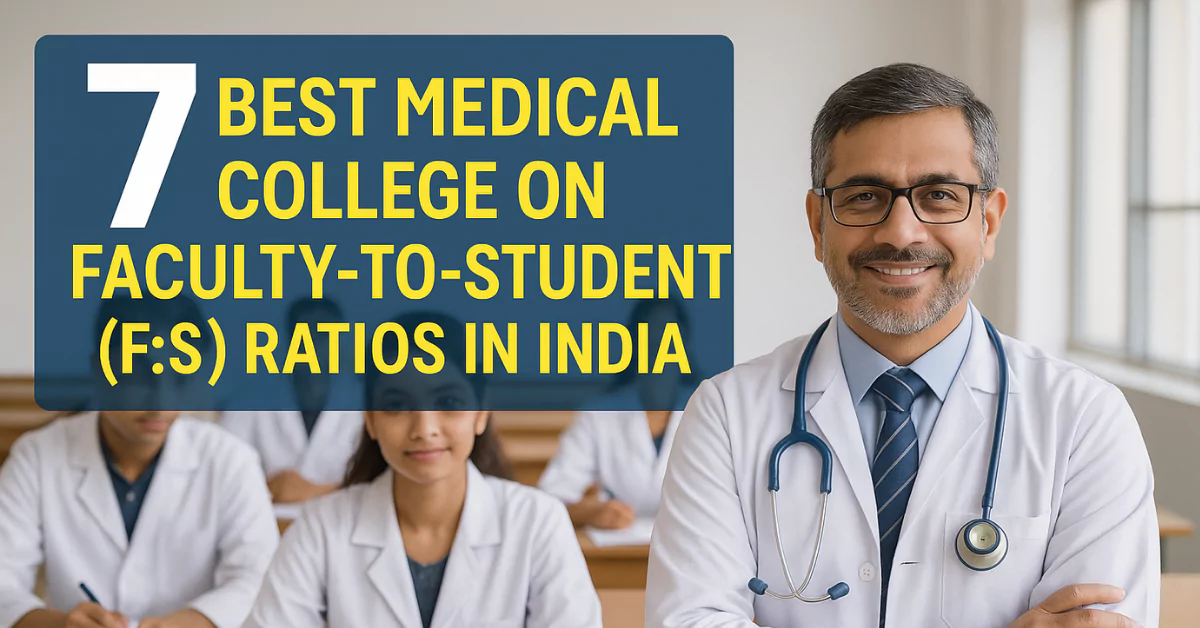MBBS College in India: The faculty-to-student ratio (F:S) is a very important parameter in medical education, directly influencing the quality of training and clinical exposure for MBBS students. This article focuses on the 7 best medical colleges on faculty-to-student (F:S) ratios in India to understand their emphasis on quality education. highlighting their commitment to maintaining optimal educational standards.
India has more than 700 colleges offering MBBS programs. Some colleges are best known for their exceptional faculty resources, ensuring personalised attention and quality clinical training. Medical colleges like AIIMS Delhi and CMC Vellore show the positive impact of high faculty-to-student ratios on medical education quality.
7 Best Medical College on Faculty-to-Student (F:S) Ratios
- All India Institute of Medical Sciences (AIIMS), New Delhi
- F:S Ratio: Approximately 1:6
- NIRF 2024 Ranking: 1
- Highlights: With over 1,700 medical students across 43 departments, AIIMS maintains a commendable F:S ratio, facilitating close mentorship and individualised training.
- Christian Medical College (CMC), Vellore
- F:S Ratio: Approximately 1:7
- NIRF 2024 Ranking: 3
- Highlights: CMC’s commitment to quality education is evident in its robust faculty strength, ensuring comprehensive training for its students.
- Jawaharlal Institute of Postgraduate Medical Education and Research (JIPMER), Puducherry
- F:S Ratio: Approximately 1:10
- NIRF 2024 Ranking: 5
- Highlights: JIPMER emphasises a balanced F:S ratio, promoting effective learning and research opportunities.
- Banaras Hindu University (BHU), Varanasi
- F:S Ratio: Approximately 1:10
- NIRF 2024 Ranking: 7
- Highlights: BHU’s Institute of Medical Sciences ensures a conducive learning environment with its optimal F:S ratio.
- Kasturba Medical College (KMC), Manipal
- F:S Ratio: Approximately 1:11
- NIRF 2024 Ranking: 9
- Highlights: KMC’s emphasis on faculty strength ensures students receive comprehensive clinical exposure.
- Amrita School of Medicine, Kochi
- F:S Ratio: Approximately 1:12
- NIRF 2024 Ranking: 8
- Highlights: Amrita’s medical college maintains a favourable F:S ratio, fostering personalised education and research.
- Maulana Azad Medical College (MAMC), New Delhi
- F:S Ratio: Approximately 1:13
- NIRF 2024 Ranking: 24
- Highlights: MAMC’s dedicated faculty ensures quality education, reflected in its respectable F:S ratio.
Note: The WHO does not prescribe a specific faculty-to-student ratio for MBBS colleges. The National Medical Commission (NMC) in India has established its guidelines for minimum faculty-to-student ratios in MBBS colleges, particularly for postgraduate (PG) courses.
| NEET UG Counselling Guide 2025 | |
|---|---|
| State-wise MBBS/BDS Counselling Guide eBook 2025 | 📥 Download |
| MCC NEET UG Counselling Guide eBook 2025 | 📥 Download |
| AACCC AYUSH NEET Counselling Guide eBook 2025 | 📥 Download |
Implications of Faculty-to-Student Ratios
- Enhanced Learning: Students get more personalised instruction, resulting in better understanding and retention.
- Improved Clinical Exposure: Smaller student groups allow for more hands-on experiences in clinical setups.
- Research Opportunities: Closer faculty interactions result in increased involvement in research projects.
- Mentorship: Students benefit from stronger mentorship relationships, guiding their academic and professional development.
These medical colleges focus on maintaining high F:S ratios, much larger than the national average of 1:29. Such ratios are instrumental in providing personal attention, improving clinical skills, and fostering research opportunities for MBBS students.
An optimal faculty-to-student ratio is critical in medical education, directly impacting the quality of training and patient care. These institutions set extraordinary standards in this aspect, ensuring the holistic development of future medical professionals.

